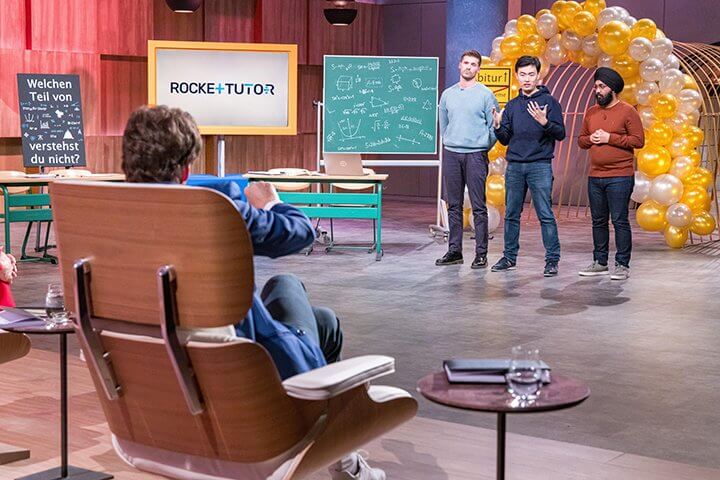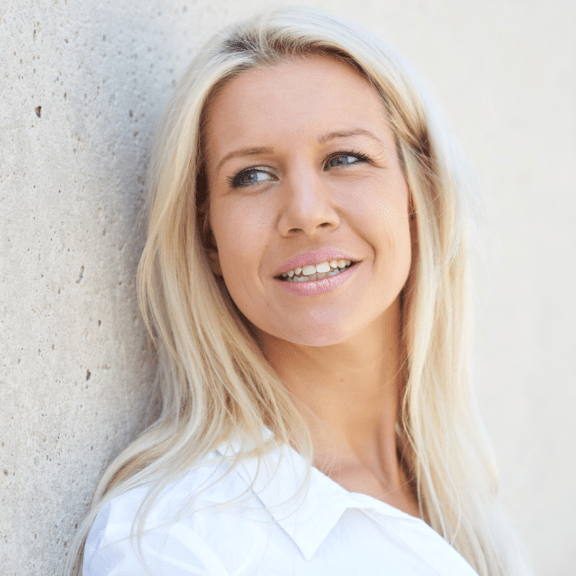RocketTutor: How positive can you talk about your startup? #DHDL
The anniversary show of ‘Die Höhle der Löwen’ had it all: not only was there another appearance by former lions Frank Thelen and Jochen Schweizer, but there was also probably the highest ‘multiple’ in the show's history: RocketTutor demanded a whopping 680 times its current turnover as a valuation for its maths learning app business. And Carsten Maschmeyer made the deal at a valuation that still corresponded to a multiple of a good 500. Do founders and lions need maths tuition themselves?
Freitag,
27.09.2024

The pitch was praised right from the start, with Frank Thelen, one of the first lions, emphasising the professional level. But what exactly excited the lions so much? The viewer is not told, and the very confident demeanour of the founders will certainly have played a large part in this. But what set this pitch apart from some of the others in the cave were the numbers, which were allowed to play a bigger role here. Especially in the venture capital environment, pitching is not primarily about the idea or the beautifully built solution, but about the question of where the startup stands and how well its business model works and will continue to develop.
Among other things, the founders show a graphic that is supposed to prove that students can improve their A-level grades by learning with the app. But if you think about it more closely, you should actually be a little perplexed. The graph shows the correlation between the learning progress made and the grades achieved. With 80% learning progress, an average grade of 1 was achieved. But what exactly does this prove? In principle, exactly what the founders claim: that grades can be improved by learning with the app. But the emphasis here is on CAN. Because what the graph only shows is that IF users achieve learning progress of around 80%, they then achieve an average grade of 1. However, it does not show how many users achieve which learning progress. In an extreme case, the users who have really made progress could therefore be in the extreme minority.
There are also indications that the graph was not created on a very large database: because 1. the curve shows strong fluctuations (users with 15% learning progress achieve a better average grade than those with over 40% learning progress) and 2. – and this should generally be surprising – the curve starts at grade 3-4, so users without measurable learning progress achieve an average grade in the sufficient range. Here one would actually expect a grade of 5-6.
Of course, there are various explanations for this. One less favourable one for the startup would be that the students who actually need it the most don’t even use the app. Another, much more favourable one would be that the app already has a strong effect without any concrete learning progress being measurable, for example through the explanations or because the task type is then also included in the Abitur and the solution has been viewed at least once. This seems rather unlikely, and there may also be other explanations for the picture in the graphic.
But taken together, at least in the edited programme, the impression is created that the lions are deeply impressed and do not question the graphic in any more detail.
Unfortunately, this is something that can also often be observed outside the cave: founders who appear very self-confident always manage to impress investors, even though the statements in their figures and graphics are not particularly strong.
Although they can still score points with the fact that in their first year, one in 10 Bavarian school leavers prepared for their maths A-level exams with the help of their app, their current turnover of around €14,000 leaves the lions almost speechless at the valuation of around €9.5 million.
This is because many investors still like to calculate the multiple, i.e. the number by which the turnover must be multiplied in order to arrive at the valuation. The lions are therefore not exactly thrilled with the multiple of the current offer of almost 700, Ralf Dümmel even comments that this is probably the highest in the history of ‘Die Höhle der Löwen’. However, multiples in such early phases must of course always be put into perspective, e.g. the €14,000 did not appear to be a complete annual turnover and no growth was included. Many other points relating to the business model – as Carsten Maschmeyer will mention later – also play a role here.
Particularly in the early phases, people also look at preliminary valuations. For example, the founders state that they still hold a 75% stake in the company and have raised 1.2 million euros in a ‘first major financing round’. It is not entirely clear whether there were any smaller financing rounds, but if these are disregarded for the time being, the founders achieved a post-money valuation of 4.8 million. With their current offer, they would therefore almost double their valuation, and that only after around half a year, based on the approximate date of recording. But even an increase of 50% would still be a lot and would have to be well justified.
Here, the founders state that they have increased their number of users 2.5-fold since then. But again, this is a very skilfully applied figure, because here too the reference value is missing. Because, to put it quite provocatively: if they had only had 10 users at first and then 25, they would also have achieved a factor of 2.5.
However, even if the chronological sequence is not entirely clear, it should be assumed that the 10% of Bavarian school leavers had already been reached at this point, which Carsten Maschmeyer honours with ‘Super achievement!’.
But how many users does that correspond to? A little internet research reveals 34,000 school leavers in Bavaria, which would mean 3400 users. Not too many for an app in its first year, especially as it is free to use and only requires a subscription for certain premium functions. This costs €15 per month, and on average the preparation for the Abitur probably takes around 4 months. The startup therefore earns around €60 with each paying customer. Unfortunately, we do not know the marketing costs and, above all, the proportion of paying customers to total users.
A quick calculation using the figures from the first year (3,400 users and €11,000 revenue, assuming the average is correctly transported) results in average revenue of just over €3 per user. Unfortunately, we don’t know anything about marketing costs.
A quick calculation with the figures from the first year (3,400 users and €11,000 turnover, if transported correctly on average) results in average revenue of just over €3 per user. Unfortunately, we don’t know anything about marketing costs.
It is therefore not clear whether the individual customer is profitable at all and to what extent the business is really scaling. The founders claim that the global demand would be huge, especially if they were to expand into the younger age groups – an argument that can certainly be understood. But whether the case is really that huge is not determined by the size of the market. After all, if the marketing costs exceed the revenue per customer, e.g. because the proportion of paying customers is very low or use is not necessarily continuous over a large part of the school career, the individual customer cannot become profitable and therefore neither can the entire company.
But perhaps the founders mean something else here too, because their sentence about profitability can also be understood differently than it initially appears. After all, they are not saying that their start-up will be profitable, but that they no longer need to worry about profitability. This can also be the case if they achieve corresponding growth and there are always investors, especially in the USA, who will pay immense valuations for a non-profitable startup until it is perhaps sold for a lot of money at some point. Here, however, we are leaving the realm of commercial start-up investments and entering the world of speculative objects.
Perhaps Carsten Maschmeyer wanted to make precisely this bet, or perhaps his due diligence process revealed far more positive figures than the viewers were told. After all, he seems to have gone through with the hard-negotiated deal of €500,000 for 7% – i.e. a valuation of around €7.1 million.
And even if it would of course be desirable for this app to help schoolchildren with their maths: what it probably can’t do is increase understanding of numbers, data and their presentation, which is something that not only founders, but unfortunately also many investors in Germany, are in dire need of.
Photo (above): TVNOW / Bernd-Michael Maurer

Ruth Cremer
Ruth Cremer ist Mathematikerin und Beraterin sowie Hochschuldozentin auf dem Gebiet der Geschäftsmodelle, Kennzahlen und Finanzplanung. Als ehemalige Investmentmanagerin weiß sie, worauf Investoren achten und hilft auch bei der Pitch- und Dokumentenerstellung im Investitions- oder Übernahmeprozess. Seit 2017 ist sie als externe Beraterin an der Auswahl und Vorbereitung der Kandidaten in "Die Höhle der Löwen" beteiligt.
